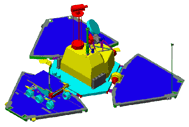

By JANE E. ALLEN, AP Science Writer
PASADENA, Calif. (AP) -- Three years after the $1 billion Mars Observer was lost in space, NASA is sending an unmanned, microwave oven-sized rover to roam across the red planet's surface to analyze rocks and the weather.
The rover named Sojourner is part of the Mars Pathfinder mission set for a Dec. 2, 1996, launch at Cape Canaveral. Once Pathfinder lands on July 4, 1997, its tulip-shaped petals will unfold to release the six-wheeled rover.
Like an honored guest stepping out on a red carpet, Sojourner will roll down an unfurled 6-foot runway. No bigger than a microwave on a small kitchen cart, the remote-control rover will give scientists their first look at Mars' composition. Pathfinder, which cost less than $300 million, is part of a flock of small Mars-bound spacecraft designed to make up some of Observer's losses. NASA also will launch Mars Global Surveyors late this year and in 1998. Observer stopped communicating with Earth just as it was about to go into orbit around Mars on Aug. 21, 1993, leaving puzzled space experts to ponder whether it exploded, continued on its outward journey or simply had a radio failure. Pathfinder would be the first U.S. spacecraft on Mars since NASA sent two Viking missions to the planet in 1976.
Engineers at NASA's Jet Propulsion Laboratory on Wednesday showed off the rover and the Pathfinder that will protect it during the launch and seven-month journey to Mars. They invited reporters to vacuum off and suit up before entering the spacecraft assembly clean room where Pathfinder, its rover, parachute, antennas and landing airbags are being prepared for additional pre-launch testing. "This is actually the first and last time that we will see Pathfinder and Sojourner completely assembled until just before launch," said Brian Muirhead, Pathfinder flight system manager and Wednesday's tour guide.
The Pathfinder lander weighs 772 pounds and stands 3.2 feet tall. Three solar panels unfold to reveal the stowed rover inside, along with antennas, a panoramic-view camera and even tiny wind socks that will take part of a planetary weather report. When Pathfinder lands during the Martian summer, daytime temperatures will be about freezing, while at night they slip a couple hundred degrees. If all goes according to plan, the Smithsonian Institution in Washington could be putting out a daily Martian weather report with information gleaned by Pathfinder, said David Dubov, Mars Pathfinder project secretary.
Once on Mars, the rover will be guided by a laser navigation system that tells it when to avoid deep depressions and big rocks. For anywhere from seven to 30 days, it will roll up to rocks, where an instrument called an alpha proton X-ray spectrometer will shoot out alpha particles whose bouncing paths tell scientists what the rocks are made of. "The entire history of the planet is held in rocks," said Howard Eisen, lead mechanical engineer for the rover.
Although Pathfinder won't be sampling for life, it will seek out the kind of complex carbon molecules that might show if Mars ever could have been hospitable to life.
Return to the Rover Home Page